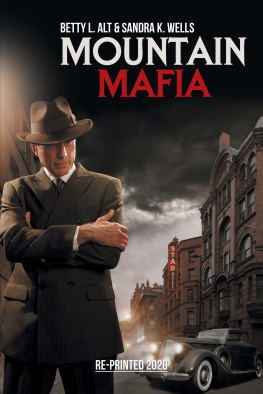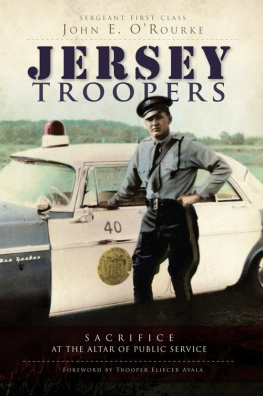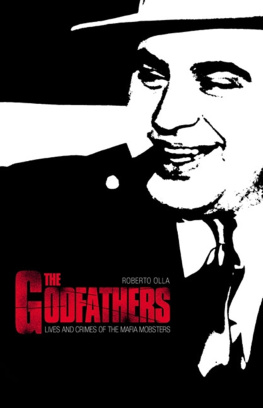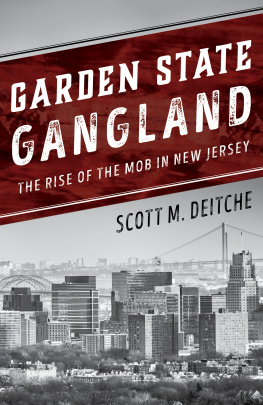Garden State Gangland
Garden State Gangland
The Rise of the Mob in New Jersey
Scott M. Deitche
ROWMAN & LITTLEFIELD
Lanham Boulder New York London
Published by Rowman & Littlefield
A wholly owned subsidiary of The Rowman & Littlefield Publishing Group, Inc.
4501 Forbes Boulevard, Suite 200, Lanham, Maryland 20706
www.rowman.com
Unit A, Whitacre Mews, 26-34 Stannary Street, London SE11 4AB
Copyright 2018 by Rowman & Littlefield
All rights reserved. No part of this book may be reproduced in any form or by any electronic or mechanical means, including information storage and retrieval systems, without written permission from the publisher, except by a reviewer who may quote passages in a review.
British Library Cataloguing in Publication Information Available
Library of Congress Cataloging-in-Publication Data
Names: Deitche, Scott M., author.
Title: Garden state gangland : the rise of the mob in New Jersey / Scott M. Deitche.
Description: Lanham : Rowman & Littlefield, [2017] | Includes bibliographical references and index.
Identifiers: LCCN 2017019023 (print) | LCCN 2017033238 (ebook) | ISBN 9781442267305 (Electronic) | ISBN 9781442267299 (cloth : alk. paper)
Subjects: LCSH: Organized crimeNew JerseyHistory. | MafiaNew JerseyHistory. | CrimeNew JerseyHistory.
Classification: LCC HV6452.N5 (ebook) | LCC HV6452.N5 D45 2017 (print) | DDC 364.10609749dc23 LC record available at https://lccn.loc.gov/2017019023
 TM The paper used in this publication meets the minimum requirements of American National Standard for Information Sciences Permanence of Paper for Printed Library Materials, ANSI/NISO Z39.48-1992.
TM The paper used in this publication meets the minimum requirements of American National Standard for Information Sciences Permanence of Paper for Printed Library Materials, ANSI/NISO Z39.48-1992.
Printed in the United States of America
Acknowledgments
I first thank my wife for all her love, support, and, especially, patience through the writing of this and all of my books.
I thank my family for their continued support. Thanks as always to my literary agent, Gina Panettieri, who is always there with advice, guidance, and the ability to make things happen. Thanks to Kathryn, Will, and all the staff at Rowman & Littlefield for their hard work in bringing the book to print.
For help with references, sources, and stories I thank Scott Burnstein, Christian Cipollini, Ed Leiber, Myron Sugerman, Joe Ricciardi, Oscar Goodman, T. J. English, George Anastasia, Tom Hunt, Dominic Woods, David Uslan, Michael Uslan, Mike Russell, John Alite, Sean Richard, Lou DiVita, Ron Fino, Sandy Lansky, G. Robert Blakey, Bob Delaney, the staff at the New Jersey State Commission of Investigation (Kathy Hennessy Riley, Lee Seglem, and Mike Hoey), Lennert van t Riet, Diane Norek Harrison, David Amoruso, Kenny K., Gary Rappaport, The Black Hand Forum and Real Deal Forum (especially B.), Avi Bash for the use of his photos, Lorcan Otway at the Museum of the American Gangster in New York, Newark Museum archivist and librarian William A. Peniston, Paul Guzzo, Glenn G. Geisheimer at Old Newark, Professor Michael Green, the staff at the Mob Museum in Las Vegas (especially Jonathan Ullman, Geoff Schumacher, Ashley Misko, and Ashley Erickson), and all my other sources.
Special thanks to Richard Warner for sharing with me his trove of materials on DAmico and Troia. And another big shout-out to Fred Martens, who allowed me access to his unparalleled library of books and materials.
For anyone I forgot, Ill catch you on the next book!
Introduction
Perth Amboy, New Jersey, is located at the confluence of the Raritan and Arthur Kill River in central New Jersey, just across the Outerbridge Crossing from Staten Island. Once an industrial powerhouse, Amboy became a rust-belt city but was able to hold on to enough of its blue-collar workers to keep it from sliding into total decay and population loss. In the 1950s, when the factories were still running, the citys population of forty-one thousand included thousands of hard laborers, working hard every day for a paycheck that paid the bills and little more.
They gathered in the local taverns and watering holes, like the Bridge Plaza Bar, after work to swap stories, drink a few beers, and maybe place a bet. Large-scale dice games and bookmaking drop-offs were scattered throughout the city. Bookmaking was happening in diverse businesses like Sciortinos Market, the Elks Club, Georges Shoe Repair Store, and the Midway Restaurant. There was some oversight by organized crime. Joseph Whitey Danzo, local labor leader, and an associate of the Elizabeth-based DeCavalcante crime family, oversaw gambling operations across Middlesex County. Gamblers like Jack Brennan and Pat Russo covered parts of Perth Amboy, and raids were not uncommon, like one in October of 1963 that netted over a dozen gambling figures.
John Lester Deitche was known to friends and family (including his grandson, the author) as Jay. He was an ironworker. Though a member of Local 399 in Camden, he worked out of Local 373 in Perth Amboy, where he also lived. Working on municipal projects and office buildings across the New York/New Jersey metro area, Jays work was tiring and physically demanding. After-work happy hours with coworkers was as common then as now.
Jay brought home the same pay as his coworkers laying out rebar. But unlike his coworkers Jay always seemed to be a little ahead. When his buddies pulled a few crumpled dollars out of their wallets to pay for drinks after work, Jay pulled out a fat money clip. At social events, while his friends wore threadbare suits that had been patched up repeatedly, he wore tailor-cut suits with encrusted tie clips. For a guy netting two hundred dollars a week, he had quite a collection of five hundred dollar suits.
Truth be known, for the better part of thirty years, Jay Deitche was a bookmaker. A World War II veteran, Deitche started bookmaking after returning home from Europe. He took bets at the bar on the ground floor of the Palace Hotel on Madison Avenue in Perth Amboy, the same hotel where he would stay when his wife, Dorothy, kicked him out for his philandering. His other betting-shop locations were the Lido Gardens Chinese restaurant and Lehighs Tavern, both in downtown Perth Amboy. When Jay was not at home, Dorothy and their son, Peter, would take any bets that came via phone. The operation had run that way for years, winding through the network of old-man bars and corner watering holes that dotted the city.
Jay also ventured southward, across the Victory Bridge that spanned the Raritan River, to South Amboy. When the bulk of his customer base started shifting that way, Jay followed. His main place of business in the early 1970s was the Gay 90s bar in South Amboy. The Gay 90s was located on First Street, in the downtown core. The bottom floor was the bar, with two apartments upstairs. The bar was a popular neighborhood hangout, a member of the local Tavern Association. It was famous for its thin-crust tomato pies. It had the usual bar amenities like a pool table and a piano player who sat behind the bar belting out the latest sing-alongs for the sloshed crowd. To the underage drinkers who frequented the bar, Jay was known as Raccoon Eyes.
In late 1972, unbeknownst to Jay, the New Jersey State Police were looking into the bookmaking activities going on at the bar, specifically targeting the bartender, whom they believed to be the ringleader. They sent in some undercover agents to stake the place out and gather intelligence. One of the undercover officers was a woman who managed to turn some heads, including Jays. Though he spent his life married to Dorothy, his eyesand handswandered often. Once, during World War II, he had his sergeants bars stripped off after making a pass and grabbing the bare leg of one of the Andrews Sisters before a USO performance.
Next page









 TM The paper used in this publication meets the minimum requirements of American National Standard for Information Sciences Permanence of Paper for Printed Library Materials, ANSI/NISO Z39.48-1992.
TM The paper used in this publication meets the minimum requirements of American National Standard for Information Sciences Permanence of Paper for Printed Library Materials, ANSI/NISO Z39.48-1992.